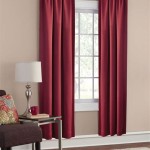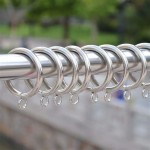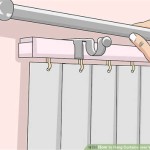3M Command Curtain Rod Hooks: A Comprehensive Guide
The 3M Command line of adhesive products has revolutionized the way individuals approach home organization and decoration. Among its diverse offerings, the Command Curtain Rod Hooks stand out as a damage-free solution for hanging curtains without the need for drilling holes or using traditional hardware. This article provides a comprehensive overview of 3M Command Curtain Rod Hooks, exploring their features, benefits, applications, installation process, limitations, and alternative solutions. It aims to equip readers with the necessary knowledge to determine if these hooks are the right choice for their curtain hanging needs.
Traditional methods of installing curtain rods often involve drilling holes into walls, which can be a significant deterrent for renters, those living in apartments with strict property management rules, or individuals simply seeking a less permanent solution. Drilling holes can damage walls, requiring patching and repainting upon removal. Furthermore, installing curtain rods with screws and anchors can be a time-consuming and potentially messy process. The Command Curtain Rod Hooks offer a compelling alternative by leveraging 3M's adhesive technology to provide a secure and damage-free hanging option.
Key Features and Benefits
3M Command Curtain Rod Hooks are designed with several key features that contribute to their ease of use and effectiveness. Understanding these features is crucial for making an informed decision about their suitability for a specific application.
Firstly, the hooks utilize 3M's Command Adhesive strips, which are known for their strong holding power and clean removal. These strips are designed to adhere to a variety of surfaces, including painted walls, wood, tile, and glass, without leaving behind any residue or causing damage upon removal. The adhesive is pressure-sensitive, meaning that it forms a strong bond with the surface when pressed firmly into place.
Secondly, the hooks themselves are typically made of durable plastic and are designed to hold a specific weight limit. It is imperative to carefully check the weight capacity of the hooks before purchasing and ensure that the chosen curtains do not exceed this limit. Overloading the hooks can result in them detaching from the wall, potentially causing damage to the curtains or the surrounding area.
Thirdly, Command Curtain Rod Hooks are designed for easy installation. The process typically involves cleaning the application surface, applying the adhesive strips to the back of the hooks, pressing the hooks firmly onto the wall, and waiting a designated period (usually an hour or more) for the adhesive to fully bond before hanging the curtain rod. Detailed instructions are always included with the product and should be followed precisely for optimal results.
The benefits of using Command Curtain Rod Hooks are numerous. The most significant benefit is the damage-free hanging option, eliminating the need for drilling and the potential for wall damage. This makes them ideal for rental properties or situations where a temporary or easily reversible solution is desired. The ease of installation is another key advantage, allowing individuals to hang curtains quickly and efficiently without the need for specialized tools or skills. The hooks are also relatively inexpensive compared to traditional curtain rod hardware, making them a budget-friendly option.
Applications and Limitations
While Command Curtain Rod Hooks offer a convenient solution for hanging curtains, it's important to understand their limitations and the specific applications for which they are best suited. Their effectiveness is highly dependent on factors such as the weight of the curtains, the type of wall surface, and the environmental conditions.
These hooks are generally recommended for lightweight to medium-weight curtains. Heavier curtains, such as those made of thick blackout material or lined fabrics, may exceed the weight capacity of the hooks and should be avoided. Using heavier curtains can lead to the hooks detaching from the wall, potentially damaging the curtains and the wall surface.
The type of wall surface also plays a critical role in the success of Command Curtain Rod Hooks. Smooth, non-porous surfaces, such as painted walls, tile, and glass, provide the best adhesion. Textured walls, such as those with heavy wallpaper or rough plaster, may not provide a sufficient surface for the adhesive to bond properly. In these situations, the hooks may not hold as securely and are more likely to detach. It is generally recommended to test the hooks in an inconspicuous area before applying them to the desired location.
Environmental conditions, such as humidity and temperature, can also affect the performance of the adhesive. High humidity levels can weaken the adhesive bond, making the hooks more prone to detachment. Similarly, extreme temperatures can also impact the adhesive's performance. It is advisable to avoid using Command Curtain Rod Hooks in areas with consistently high humidity or extreme temperature fluctuations, such as bathrooms or near sources of heat.
Another limitation to consider is the aesthetic appearance of the hooks. While Command Curtain Rod Hooks are designed to be relatively discreet, they are still visible on the wall. For some individuals, this may be a less desirable option compared to traditional curtain rod hardware, which can be more decorative and integrated into the overall room design.
Installation Process and Best Practices
Proper installation is crucial for ensuring the effectiveness and longevity of Command Curtain Rod Hooks. Following the manufacturer's instructions carefully and adhering to best practices can significantly improve the success rate and prevent potential issues.
The first step in the installation process is surface preparation. The wall surface should be clean, dry, and free of dust, dirt, and grease. Use a clean cloth and rubbing alcohol to thoroughly clean the area where the hooks will be applied. Allow the surface to dry completely before proceeding. This step is essential for ensuring that the adhesive strips can form a strong bond with the wall.
Next, carefully apply the adhesive strips to the back of the hooks, following the instructions provided with the product. Ensure that the strips are properly aligned and firmly pressed onto the hooks. Peel off the protective liners from the adhesive strips, exposing the adhesive surface.
Position the hooks on the wall in the desired location, ensuring that they are level and properly spaced to accommodate the curtain rod. Press the hooks firmly onto the wall for at least 30 seconds to allow the adhesive to bond with the surface. It is important to apply even pressure across the entire surface of the hooks to ensure a strong and secure bond.
After applying the hooks, it is crucial to wait the recommended amount of time before hanging the curtain rod. The manufacturer typically recommends waiting at least one hour, or preferably longer, to allow the adhesive to fully cure and reach its maximum holding strength. Rushing this step can compromise the bond and increase the risk of the hooks detaching.
When hanging the curtain rod, ensure that the weight of the curtains does not exceed the weight capacity of the hooks. Distribute the weight evenly across the hooks to avoid overloading any single point. If the curtains are particularly heavy, consider using additional hooks for added support.
To remove the Command Curtain Rod Hooks, follow the instructions provided with the product. Typically, this involves gently pulling the adhesive strips straight down the wall, parallel to the surface. Avoid pulling the strips away from the wall at an angle, as this can cause them to break or tear, leaving behind residue or damaging the wall. If the strips break or tear, carefully remove any remaining residue with a clean cloth and rubbing alcohol.
Regularly inspect the hooks to ensure that they are still securely attached to the wall. If you notice any signs of loosening or detachment, remove the hooks and reapply them using new adhesive strips. Avoid using damaged or weakened hooks, as they may not provide sufficient support.
By following these installation guidelines and best practices, individuals can maximize the effectiveness and longevity of Command Curtain Rod Hooks and enjoy the benefits of a damage-free curtain hanging solution.
Alternative Solutions
While 3M Command Curtain Rod Hooks offer a convenient and damage-free option for hanging curtains, they may not be suitable for all situations. In cases where the hooks are not a viable solution, there are several alternative options to consider, each with its own advantages and disadvantages.
Spring tension rods are a popular alternative for hanging curtains without drilling holes. These rods use spring tension to hold them in place between two surfaces, such as the inside of a window frame or between two walls. Spring tension rods are relatively inexpensive and easy to install, making them a good option for renters or those seeking a temporary solution. However, they are typically only suitable for lightweight curtains and may not be as aesthetically pleasing as traditional curtain rods.
Magnetic curtain rods are another option for hanging curtains on metal surfaces, such as steel doors or metal window frames. These rods use magnets to attach to the metal surface, providing a secure and damage-free hanging option. Magnetic curtain rods are easy to install and remove, and they are available in a variety of styles and sizes. However, they are only suitable for metal surfaces and may not be strong enough to support heavy curtains.
For more permanent and secure curtain hanging solutions, traditional curtain rod hardware is often the best choice. Traditional curtain rods are typically installed using screws and anchors, providing a strong and stable support for curtains of all weights. While installing traditional curtain rods requires drilling holes and using tools, the result is a more durable and aesthetically pleasing solution.
Adhesive-backed curtain rod brackets are an alternative to 3M Command Hooks. These brackets use a stronger adhesive designed for more weight, but might cause damage. Reviewing the wall surface and the weight limitations is key to using this alternative option.
Ultimately, the best solution for hanging curtains depends on individual needs and preferences, as well as the specific characteristics of the wall surface and the weight of the curtains. Carefully consider all available options before making a decision to ensure that the chosen solution provides a safe, secure, and aesthetically pleasing result.

17053bn 2es

Command Decorative Matte Black Curtain Rod Holders 3m United States

How To Hang Curtains With Hooks Command 3m Singapore

Hang Curtains Without Damaging Walls Command Hooks 3m Australia

Command Decorative Satin Nickel Curtain Rod Hooks 3m United States

Command Curtain Rod Hooks 17053bn 2ef 2 Strips 3m Canada

2pk Curtain Rod Hooks Command

Command Large Decorative Brushed Nickel Adhesive Storage Utility Hook 5 Lb Capacity 17053bn Es At Com

Command Curtain Rod Hooks 17053bn 2ef 2 Strips 3m Canada

Command Decorative Matte Black Curtain Rod Hooks 3m United States
See Also








